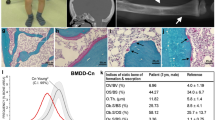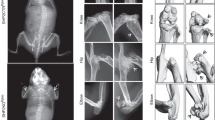Abstract
THE vertebrate skeleton is formed primarily by endochondral ossification, starting during embryogenesis when cartilage anlagens develop central regions of hypertrophic cartilage which are replaced by bony trabeculae and bone marrow1,2. During this process chondrocytes express a unique matrix molecule, type X collagen3. We report here that mice carrying a mutated collagen X transgene develop skeletal deformities including compression of hypertrophic growth plate cartilage and a decrease in newly formed bone, as well as leukocyte deficiency in bone marrow, reduction in size of thymus and spleen, and lymphopenia. The defects indicate that collagen X is required for normal skeletal morphogenesis and suggest that mutations in COL10A1 are responsible for certain human chondrodysplasias, such as Spondylometaphyseal dysplasias and metaphyseal chondrodysplasias4.
This is a preview of subscription content, access via your institution
Access options
Subscribe to this journal
Receive 51 print issues and online access
$199.00 per year
only $3.90 per issue
Buy this article
- Purchase on Springer Link
- Instant access to full article PDF
Prices may be subject to local taxes which are calculated during checkout
Similar content being viewed by others
References
Ham, A. W. Histology 5th edn 384–457 (Lippincott, Philadelphia, 1965).
Caplan, A. I. & Pechak, D. G. Bone Min. Res. 5, 117–183 (1987).
Jacenko, O., Olsen, B. R. & LuValle, P. Crit. Rev. Eukaryotic Gene Exp. 1, 327–353 (1991).
McKusick, V. A., Francomano, C. A. & Antonarakis, S. E. (eds) Mendelian Inheritance in Man. Catalogs of Autosomat Dominant, Autosomal Recessive, and X-linked Phenotypes For examples, see Vol. 1, entry numbers 156500, 156400, 184250, 184253, and Vol. 2, entry numbers 250250, 260400, 271660 (The Johns Hopkins University Press, Baltimore, London, 1992).
Schmid, T. M., Popp, R. G. & Linsenmayer, T. F. Ann. N.Y. Acad. Sci. 580, 64–73 (1990).
Gibson, G. J. & Flint, M. H. J. Cell Biol. 101, 277–284 (1985).
Brass, A., Kadler, K., Thomas, J. T., Grant, M. E. & Boot-Handford, R. P. FEBS Lett. 303, 126–128 (1992).
Apte, S. S., Seldin, M. F., Hayashi, M. & Olsen, B. R. Eur. J. Biochem. 206, 217–224 (1992).
LuValle, P., Ninomiya, Y., Rosenblum, N. D. & Olsen, B. R. J. biol. Chem. 263, 18378–18385 (1988).
LuValle, P., Iwamoto, M., Fanning, P., Pacifici, M. & Olsen, B. R. J. Cell Biol. 121, 1173–1179.
Grigoriadis, A., Heersche, J. M. & Aubin, J. E. Devl Biol. 142, 313–318 (1990).
Summers, T. A., Irwin, M. H., Mayne, R. & Balian, G. J. biol. Chem. 263, 581–587 (1988).
Iyama, K.-I. et al. Anat. Rec. 229, 462–472 (1991).
Kwan, A. P. L., Cummings, C. E., Chapman, J. A. & Grant, M. E. J. Cell Biol. 114, 597–604 (1991).
Sawada, H., Konomi, H. & Hirosawa, K. Eur. J. Cell Biol. 110, 219–227 (1990).
Warman, M. L. et al. Nature Genet. (in the press).
Ninomiya, Y. et al. in Extracellular Matrix Genes (eds Sandell, L. J. & Boyd, C. D.) 79–113 (Academic, New York, 1990).
Luckow, B. & Schütz, G. Nucleic Acids Res. 15, 5490 (1987).
Lair, P. W. et al. Nucleic Acids Res. 19, 4293 (1991).
Author information
Authors and Affiliations
Rights and permissions
About this article
Cite this article
Jacenko, O., LuValle, P. & Olsen, B. Spondylometaphyseal dysplasia in mice carrying a dominant negative mutation in a matrix protein specific for cartilage-to-bone transition. Nature 365, 56–61 (1993). https://doi.org/10.1038/365056a0
Received:
Accepted:
Issue Date:
DOI: https://doi.org/10.1038/365056a0
This article is cited by
-
“Lessons from Rare Forms of Osteoarthritis”
Calcified Tissue International (2021)
-
The Effect of β-Aminopropionitrile on Skeletal Micromorphology and Osteogenesis
Calcified Tissue International (2018)
-
Extracellular Matrix and Developing Growth Plate
Current Osteoporosis Reports (2014)
-
Col10a1 gene expression and chondrocyte hypertrophy during skeletal development and disease
Frontiers in Biology (2014)
-
Stress relaxation of swine growth plate in semi-confined compression: depth dependent tissue deformational behavior versus extracellular matrix composition and collagen fiber organization
Biomechanics and Modeling in Mechanobiology (2013)
Comments
By submitting a comment you agree to abide by our Terms and Community Guidelines. If you find something abusive or that does not comply with our terms or guidelines please flag it as inappropriate.



